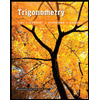Highlight each graph below depicting the domain used to create each inverse trigonometric function. x Clear 211 Undo f(x) = sin(x) 10 5 -5 -10 Redo 211 -21 f(x) = cos(x) 10 -5 -5 -10 211 201 f(x) =tan(x) 10 -5 10 211
Highlight each graph below depicting the domain used to create each inverse trigonometric function. x Clear 211 Undo f(x) = sin(x) 10 5 -5 -10 Redo 211 -21 f(x) = cos(x) 10 -5 -5 -10 211 201 f(x) =tan(x) 10 -5 10 211
Trigonometry (11th Edition)
11th Edition
ISBN:9780134217437
Author:Margaret L. Lial, John Hornsby, David I. Schneider, Callie Daniels
Publisher:Margaret L. Lial, John Hornsby, David I. Schneider, Callie Daniels
Chapter1: Trigonometric Functions
Section: Chapter Questions
Problem 1RE:
1. Give the measures of the complement and the supplement of an angle measuring 35°.
Related questions
Question

Transcribed Image Text:**Understanding Domains for Inverse Trigonometric Functions**
The image contains three graphs illustrating the functions \( f(x) = \sin(x) \), \( f(x) = \cos(x) \), and \( f(x) = \tan(x) \). Each graph represents the standard trigonometric function necessary to form their respective inverse functions. Let's examine each graph in detail:
1. **Graph of \( f(x) = \sin(x) \)**:
- The sine function graph oscillates between -1 and 1 along the y-axis.
- The period of the sine function is \( 2\pi \), meaning it repeats every \( 2\pi \) units.
- The key segment that is typically highlighted to create the inverse sine function, \( \sin^{-1}(x) \) or arcsin(x), is usually from \(-\frac{\pi}{2}\) to \(\frac{\pi}{2}\).
2. **Graph of \( f(x) = \cos(x) \)**:
- The cosine function also oscillates between -1 and 1.
- Like the sine function, it has a period of \( 2\pi \).
- For the inverse cosine function, \( \cos^{-1}(x) \) or arccos(x), the domain typically used is from 0 to \(\pi\).
3. **Graph of \( f(x) = \tan(x) \)**:
- The tangent function displays vertical asymptotes where the function is undefined, occurring at \( x = \frac{\pi}{2} + n\pi \) for any integer \( n \).
- The pattern repeats every \( \pi \) units.
- For the inverse tangent function, \( \tan^{-1}(x) \) or arctan(x), the highlighted domain is usually from \(-\frac{\pi}{2}\) to \(\frac{\pi}{2}\).
Each graph supports the visual understanding of the trigonometric function's behavior over its important domain, which is used for deriving the inverse function.
These graphs are essential for understanding how the domains are restricted to ensure that the inverse trigonometric functions are bijective and thus properly defined.
Expert Solution
This question has been solved!
Explore an expertly crafted, step-by-step solution for a thorough understanding of key concepts.
This is a popular solution!
Trending now
This is a popular solution!
Step by step
Solved in 3 steps with 3 images

Recommended textbooks for you

Trigonometry (11th Edition)
Trigonometry
ISBN:
9780134217437
Author:
Margaret L. Lial, John Hornsby, David I. Schneider, Callie Daniels
Publisher:
PEARSON

Trigonometry (MindTap Course List)
Trigonometry
ISBN:
9781305652224
Author:
Charles P. McKeague, Mark D. Turner
Publisher:
Cengage Learning


Trigonometry (11th Edition)
Trigonometry
ISBN:
9780134217437
Author:
Margaret L. Lial, John Hornsby, David I. Schneider, Callie Daniels
Publisher:
PEARSON

Trigonometry (MindTap Course List)
Trigonometry
ISBN:
9781305652224
Author:
Charles P. McKeague, Mark D. Turner
Publisher:
Cengage Learning


Trigonometry (MindTap Course List)
Trigonometry
ISBN:
9781337278461
Author:
Ron Larson
Publisher:
Cengage Learning